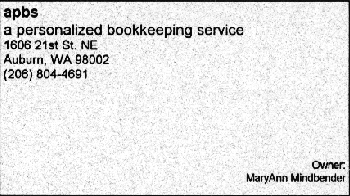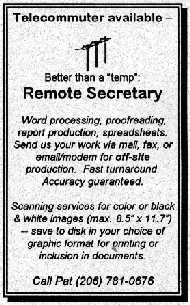.gif) the M-factor
the M-factor.gif)
.gif) the M-factor
the M-factor.gif)

by Pat Moore
As we begin our second year as an independent cost estimating firm, we look
back at a very successful beginning and forward to a number of exciting new
projects. We are currently in the process of applying for WBE certification.
Bruce McKay and I invite you to read our new company newsletter and to give us
a call with feedback and ideas for future articles. We have worked on a
variety of projects this year, many of which have been medical facilities. For
that reason, we have chosen Hospital Budgeting and Estimating as this issues
Feature Article.


Budgeting for a hospital remodel/renovation requires (1) a thorough understanding of hospital construction, procedures, and new technology; and (2) an open liaison between user, designer, estimator, and contractor (depending on contract arrangements).
How do we establish a budget initially when there are no drawings?
A realistic framework of requirements can be built up over a relatively
short period of time. This creates the model which becomes a working tool for
all participants.
.gif)
Additional scope items can be added as the budget is being developed along with contingency amounts based on the level of information available.
Once the framework has been established, a first pass at the budget can be
attempted. From the list generated above, information is provided which
answers the questions and consequently gives flesh to the skeletal budget.


1. Departments affected?
 How many departments will be affected?
How many departments will be affected?
 What is the impact on adjacent areas?
What is the impact on adjacent areas?
 What is the magnitude of the project?
What is the magnitude of the project?
 Is the function new or existing?
Is the function new or existing?
 Are there new technologies?
Are there new technologies?
 Is the project single or multi-story?
Is the project single or multi-story?
 Consider safety (X-ray, radiology,
radiation).
Consider safety (X-ray, radiology,
radiation).

2. Level of quality?
 Get client input.
Get client input.
 Quality may be market driven (What have other
hospitals done, or are doing, in the competition area?)
Quality may be market driven (What have other
hospitals done, or are doing, in the competition area?)
 Patient satisfaction is a major focus.
Patient satisfaction is a major focus.
 Attention must be given to community
presence.
Attention must be given to community
presence.
 Employee satisfaction must also be taken into
consideration.
Employee satisfaction must also be taken into
consideration.

3. Seismic/Code Issues?
 Evaluate maintenance vs. first cost.
Evaluate maintenance vs. first cost.
 Is the project in compliance?
Is the project in compliance?
 What is the architect/design team
responsibility?
What is the architect/design team
responsibility?
 The impact on costs depends on
requirements.
The impact on costs depends on
requirements.
 It is necessary to have a thorough
understanding of seismic and building codes.
It is necessary to have a thorough
understanding of seismic and building codes.
 Are there any mitigating issues?
Are there any mitigating issues?
 Who is responsible for negotiations with
responsible agencies?
Who is responsible for negotiations with
responsible agencies?

4. Mechanical and Electrical?
 Demand may be exceeded.
Demand may be exceeded.
 Perform a careful analysis of needs (current
& future).
Perform a careful analysis of needs (current
& future).
 Systems must be appropriate for
departments.
Systems must be appropriate for
departments.
 Provide ease of access for maintenance.
Provide ease of access for maintenance.
 Controls (one-source tied into existing?):
proprietary?
Controls (one-source tied into existing?):
proprietary?

 What are new systems requirements: nurse call, fire alarm,
What are new systems requirements: nurse call, fire alarm,  High-efficiency fixtures.
High-efficiency fixtures.  SF costs vs. running costs.
SF costs vs. running costs. Choice of fuel: flexible, inflexible.
Choice of fuel: flexible, inflexible. Sprinklers: type, required, new, add to existing.
Sprinklers: type, required, new, add to existing. Comparative costs.
Comparative costs.
5. Phasing?
.gif)
 Phasing has a major impact on costs.
Phasing has a major impact on costs.
 Do phased areas have to be completed before
next phase begins?
Do phased areas have to be completed before
next phase begins?
 What is the phasing plan/schedule?
What is the phasing plan/schedule?
 What is the necessity of trades going off and
on site?
What is the necessity of trades going off and
on site?
 Determine overhead cost.
Determine overhead cost.
 Productivity.
Productivity.
 Phasing packages.
Phasing packages.

6. Restrictions?
.gif)
 Careful analysis will determine cost impacts.
Careful analysis will determine cost impacts.
7. Schedule?
 A realistic schedule is essential for work
to be accomplished and costed accordingly: overtime? shift work?
weekends?
A realistic schedule is essential for work
to be accomplished and costed accordingly: overtime? shift work?
weekends?

8. Other Costs?
 Make sure ALL items are included.
Make sure ALL items are included.
All responsible and involved personnel to review and ensure everything is
included.
 Cost consultant should review, and can
help develop check list for items sometimes forgotten or not
considered.
Cost consultant should review, and can
help develop check list for items sometimes forgotten or not
considered.

9. Contingencies
 Mistakes happen.
Mistakes happen.
 Escalation is an important consideration.
Escalation is an important consideration.




If you have email or a web presence, and would like to be included on our Industry Links Page, please let us know. We will add your listing in our next update.


 by James T. Frane, Craftsman Book Company, 1994
by James T. Frane, Craftsman Book Company, 1994
M-factor: a number used to designate the relative heat retention properties of a mass. For example, one of the ways of storing heat energy in a solar heating system is to use a material of dense mass, such as a wall of water containers. The water containers are exposed to sunlight through a wall of windows and they absorb and store the heat. A large percentage of the heat gained from the sunlight is stored and given off slowly to heat the surrounding air when the sunlight is gone. The M-factor represents the thermal storage capacity of the water containers.
thermal mass: a material of sufficient density to absorb and retain
heat, such as concrete block. Such a material may be used to build
heat-absorbing wall in a passive solar heating system. The wall will absorb
heat from the sun though a window during the day, and give up that heat into
the building during the night, warming the air around it.




Click here to visit the Remote Secretary page.
The McKay/Moore Partnership
Bruce McKay/Patricia Moore
Construction Cost Control Consultants
7323 Eleventh Avenue NW
Seattle, WA 98117-4142
Phone or fax/data:
(206) 781-0676 
email: mckaymoore@strabo.com
Go back to
McKay/Moore's Home Page